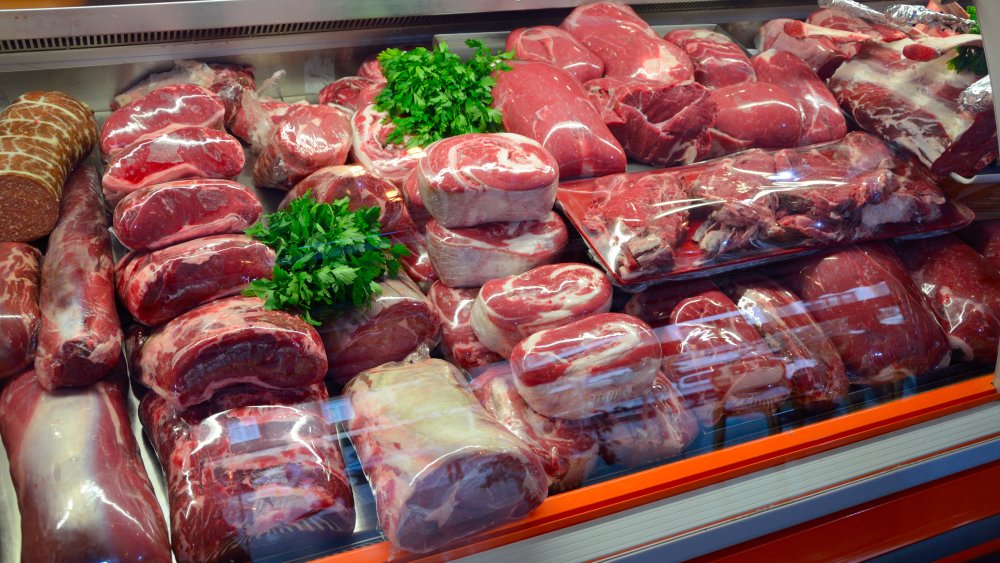The Real Reason Red Meat Is So Controversial
Red meat, for many years, was the staple of American diets, and is the type of meat we think of when the phrase "meat and potatoes" is used. When asked to name a red meat, the first thing most of us would think of is beef — steak, roast beef, burgers. Beef isn't the only red meat, however. Despite its marketing claims to be "the other white meat," Nutrition Advance states that pork is considered a red meat due to the large amount of myoglobin it contains, this being a protein that gives meat its reddish coloring. Other types of red meat include lamb or mutton (both are the meat of the sheep at different stages in its life cycle), bison, venison, and wild boar.
Healthline also brings up another type of red meat, that being processed meat. Examples of processed red meats would include bacon (though not the turkey kind, which is processed white meat), pork sausages, beef jerky, and hot dogs.
What makes red meat good for you?
Red meat can be very nutrient-dense. Taking, as an example, a serving of 80 percent lean ground beef, in a 100 gram (3.5 ounce) portion, approximately the amount that would go into your basic quarter-pound burger, Nutrition Data shows us that this portion comes in at a reasonable 256 calories. With this, you get 17.2 grams of protein, or 34 percent (over one third) of your daily recommended value of this nutrient. You also get 21 percent of your day's niacin, along with 16 percent of your necessary vitamin B6, 36 percent of your vitamin B12, 16 percent of your phosphorus, 28 percent of your zinc, and 21 percent of your selenium.
That same portion of ground beef also contains 11 percent of your daily recommended iron. While beef may not be as high in iron as certain other foodstuffs, including lentils, spinach, and even dark chocolate, the National Institutes of Health points out that heme iron, the type available only in meats and seafood, is far more bioavailable (meaning: able to be absorbed by the body) than is non-heme (plant-based) iron. They, therefore, list the recommended daily amount of iron for vegetarians as 1.8 times higher than that recommended for meat-eaters.
Why red meat is thought to be bad
Healthline brings up a number of studies where red meat consumption has been linked to increased rates of heart disease, diabetes, and cancer. They point out the fact that many of these studies have been observational in nature, meaning that they are able to show an association between the two but not supply any proof that the former causes the latter — and, as you may recall from Intro to Logic, correlation does not equal causation. Just because it rains every time you leave the house without an umbrella doesn't mean that your actions are affecting the weather, nor do these studies supply any kind of proof that red meat itself makes people more susceptible to disease. Another complicating factor is that many of these studies seem to lump all red meats in together, without separating out processed and unprocessed meats, and there's some likelihood that the processing itself may be what is the real risk factor.
The New York Times points out that meat consumption, in general, is problematic for many as it raises concerns outside of merely health matters. Livestock production is causing undeniable harm to the environment. Plus, there are also those tricky ethical issues raised by organizations such as PETA. Still, they acknowledge that the health concerns said to be associated with red meat eating over the past few decades look to have been somewhat overblown.
How you can minimize any health risks from red meat
The one area in which non-processed red meat may still raise some red flags, health-wise, lies in the fact that it can form harmful compounds including heterocyclic amines (HAs), polycyclic aromatic hydrocarbons (PAHs), and advanced glycation end-products (AGEs) when cooked at high temperatures. All of these substances have been found to cause cancer in animals, so this could explain some of the reasoning behind why there may be a link between red meat consumption and certain types of cancer. While there is no definitive proof that red meat has anything to do with cancer in humans, if you want to be sure you're preparing it in the safest method possible, Healthline offers some tips.
Lower heat methods such as stewing or sous vide will reduce the chance of any bad chemicals coming into play, as will keeping any high heat cooking to a minimum. (The reverse sear steak prep method where you bake at low heat and follow up with just a short stint in the pan would be pretty low risk.) They also suggest frequent flipping to keep your meat from burning, and cutting off any charred bits — smoked foods are also not considered too safe. Finally, a tasty meat marinade made from garlic, lemon juice, olive oil, and/or red wine seems to reduce the presence of HAs significantly, as well as adding extra added deliciousness.




